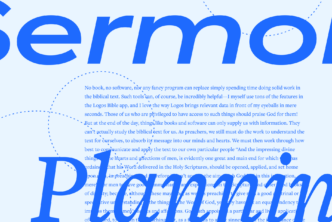On the Logos Newsgroups, a user asked a question about syntax searching:
I’d like to search for every instance of the construction in Heb 1:2 — ἐν υἱῷ – i.e. ἐν followed by noun without article … Also (I think) in 1 Thess 1:5 – ἐν λόγῳ — our gospel did not come to you not simply “by means of wordspeech”
I could do a normal search, but is this a category of construction that I could find with a syntax search? If so, could someone perhaps suggest how to go about it?
The answer is a resounding “YES!” It was like a slow-pitch softball that I couldn’t resist swinging at. So I did. You can watch the video now (Flash, 9 megs, with sound) but be sure to read the rest of the post too.
I should note that I’m running 3.0a beta 2, and you may see some visual changes inside of the Syntax Search Dialog.
The query I show in the video is in two parts. First, I solve the problem of finding a prepositional phrase with the preposition of ?? and an anarthrous (so, no article) dative object. There are a few hoops to jump through to specify the structure.
Hoop 1: Prepositions in OpenText.org word groups
In OpenText.org word groups, prepositional phrases function two different ways. The most common way is for the whole prepositional phrase to also be a word group; this whole structure then functions as an Adjunct clause component, usually modifying the Predicator in the clause. This is specified by searching within the head term for a modifier that is a specifier that modifies a word in the head term.
However, it is also possible for the prepositional phrase to function within the word group, acting as a whole to modify a word within the word group. When this happens, the prepositional phrase is called a relator. The OpenText.org folks define it like this:
A Relator is a modifier which is specified by a preposition (i.e. the Relator is the object of a preposition) that modifies another element within the word group. For example, in the word group ?? ???? ??? ????????, the term ??? is in a relator relationship with the head term ????????. This relationship only applies to prepositional phrases within word groups and not when the prepositional phrase functions as a clause component.
Porter, S., O’Donnell, M. B., Reed, J. T., Tan, R., & OpenText.org. (2006; 2006). The OpenText.org Syntactically Analyzed Greek New Testament Glossary. Logos Research Systems, Inc.
Basically, we’re searching for the same structure (specifier that is a preposition modifying a word) within different containers (one as a head term, the other as a modifier). Both of these need to be specified in the query with an OR serving to join them as alternates.
Hoop 2: Occurrence Options
Another hoop involves the anarthrous-ness of the dative prepositional object. When a preposition and an article act as specifiers modifying a word, it usually looks something like this:

Here you can see that the specifier has two words as its content, the preposition and the article. We’re only interested in finding when there is one thing in the specifier: the preposition. So we use the
Occurrence option Must be only child of parent. This means that the parent structure (the modifier) only has one child (the word). If there are two words, it will not qualify as a hit. Checking this option will allow us to find anarthrous (i.e. article-free) prepositional objects.
Hoop 3: Optional Modifier
One more hoop involves accounting for an optional modifier between the preposition and the object. I’ve done this by adding a modifier that can be either a definer or a qualifier (though I suppose it could also be a relator … ) that May Repeat. This means that the modifier may not occur at all, or it may occur any number of times between what precedes and what follows. This as well is set in the Occurrence options for the modifier, selecting the May be repeated any number of times option.
Hoop 4: Multiple Possible Words
The last hoop, shown in the second part of the video, involves specifying multiple possible lemmas. This is easy, it is done by typing the necessary word into the Lexeme box and hitting enter or hitting the green go button. Enter then next word, and the list is there.
Conclusion
Hopefully this helps in explaining some issues in syntax searching. In short, yes, this is the sort of question that syntax searching helps answer.
Now that you’ve read all of this, hopefully the video will make more sense. Here’s the link again:





